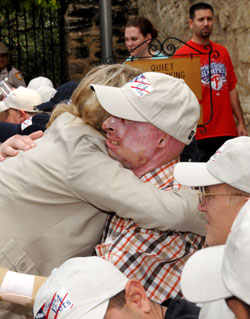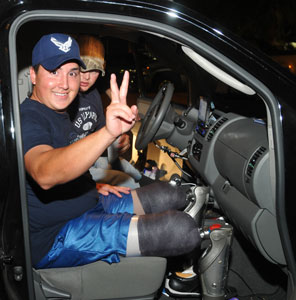Customer Access
Purchasing Goods and Services: What to Expect
There are over seven million businesses in the United States that provide goods or services to the public, including grocery stores, retail stores, restaurants and bars, hotels and motels, gas stations, dry cleaners, laundromats, banks, law offices, medical offices, insurance agencies, movie theaters, art museums, gyms, amusement parks, and other businesses. All businesses that provide goods or services to the public, even small ones with only one or two employees, must comply with the ADA, including the following requirements:
Reasonable Modifications
Businesses must make "reasonable modifications" in their policies, practices, or procedures when necessary so that people with disabilities can be their customers. Businesses are not, however, required to make any changes that would fundamentally alter or change the nature of the business or its services. Additional information about the rules for "reasonable modifications" can be found at www.ada.gov/reachingout/lesson11.htm or by calling the ADA Information Line. See Contact Information.
Typical examples of reasonable modifications are:
- Modifying a no-pets policy to allow someone with PTSD to bring in a service animal that has been trained to calm the person when he or she has an anxiety attack.
- Modifying a membership policy at a health club to allow a person who uses a wheelchair to bring an aide to provide assistance in getting on and off exercise equipment, in and out of a swimming pool, or to assist with showering and dressing in the locker room, at no additional charge to the club member.
- Instructing staff that if a customer who has lost the use of his or her arms asks them to reach into a shirt or jacket pocket to retrieve the wallet or credit card needed to pay the bill, they should honor the request.
- Modifying procedures at a bank so customers who have difficulty standing for a long time can sit down without losing their place in line.
- Providing refueling assistance at the self-serve price for a customer with a disability who cannot pump his or her own gas.
An example of a fundamental alteration or change is:
- At a gas station with only one employee whose primary job is to protect the cash box or activate the gas pumps remotely, it would be a fundamental change for the employee to leave his or her post unattended in order to pump gas for a customer with a disability.
Effective Communication
Businesses must communicate effectively with customers who have vision, hearing, or speech disabilities. The businesses, not the customers, are responsible for providing the tools or services that are needed for "effective communication." Businesses are not, however, required to provide any tools or services that would be an "undue burden," which means significant difficulty or expense. The type of tool or service needed depends on the nature of the communication as well as the particular customer´s disability. Additional information about the rules for "effective communication" can be found at www.ada.gov/reachingout/lesson21.htm or by calling the ADA Information Line. See Contact Information.
Examples of effective communication are:
- At a restaurant, the waiter can read the menu to a person with vision loss.
- At a grocery store, a staff person can assist a person with vision loss by locating and retrieving items from the shelves or reading price and content information to him or her.
- At an apartment rental office, the agent can provide a large print copy of a rental contract for a person who has vision loss or an audiotaped or electronic copy for a person who is blind.
- At a retail store, the sales person can write notes to answer simple questions from a customer who is deaf or has hearing loss.
- At a movie theater, staff can provide an assistive listening device for someone who has hearing loss.
- A pizza delivery service must accept calls through the telephone relay service from a customer who uses a TTY because of a speech disability.
New Construction and Alterations
Businesses whose facilities were built or altered since the ADA went into effect must comply with the ADA Standards for Accessible Design so that the facility is accessible to and usable by people who have mobility disabilities as well as people who have sensory disabilities and people who have limited dexterity or grasping ability.
Barrier Removal
In addition, businesses have a continuing obligation to remove architectural barriers when it is "readily achievable" to do so. For example, if inaccessible features in an older facility can be corrected easily and inexpensively, they must be corrected. If there are several inaccessible features and it is not easy and inexpensive to correct them all at once, they should be corrected over time.
When an inaccessible feature cannot be corrected, if there is another easy and inexpensive way to provide service to a customer who cannot access the business, the business must offer that alternative for the customer.
Additional information about the rules for "barrier removal" can be found at www.ada.gov/reachingout/lesson41.htm or by calling the ADA Information Line. See Contact Information.
Inexpensive steps businesses might take to improve access may include:
- Installing a ramp over a step or two at the main entrance.
- Making a curb cut in the business's sidewalk.
- Rearranging tables, chairs, vending machines, display racks, and other furniture to allow for easy passage throughout the business.
- Installing grab bars in a toilet stall.
- Lowering a bathroom's paper towel dispenser.
- Restriping a portion of the parking lot to create accessible parking spaces.
- Installing a paper cup dispenser at an inaccessible water fountain.
Examples of alternative ways to serve a customer when barrier removal is not feasible are:
- At a dry cleaner's, providing curb-side service for a customer dropping off or picking up clothes.
- At a neighborhood restaurant, providing home delivery or carry-out service for a customer who cannot enter the restaurant.
For more information about these provisions or how to file a complaint, see Contact Information for the U.S. Department of Justice.



User Comments/Questions
Add Comment/Question